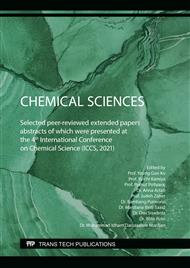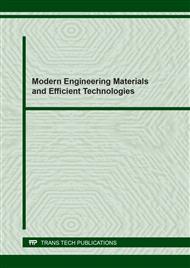[1]
MC Li, Q. Wu, K. Song, CF De Hoop, S. Lee, Y. Qing, Y. Wu, Cellulose Nanocrystals and polyanionic cellulose as additives in bentonite water-based drilling fluids: rheological modelling and filtration mechanisms, Ind. Eng. Chem. Res. 55 (2015) 133–143.
DOI: 10.1021/acs.iecr.5b03510
Google Scholar
[2]
M. Magzoub. M. Mahmoud, M. Nasser, I. Hussein, S. Elkatatny, A. Sultan, Thermochemical upgrading of calcium bentonite for drilling fluid applications, J. Energy Resour. Technol. 141 (2019) 042902.
DOI: 10.1115/1.4041843
Google Scholar
[3]
B. Satiyawira, Pengaruh temperatur terhadap sifat fisik sistem low solid mud dengan penambahan aditif biopolimer dan bentonite extender, Jurnal Petro 7 (2018) 144–151.
DOI: 10.25105/petro.v7i4.4282
Google Scholar
[4]
M.I. Magzoub, I.A. Hussein, M.S. Nasser, M. Mahmoud, AS Sultan, A. Benamor, An investigation of the swelling kinetics of bentonite systems using particle size analysis, J. Dispersion Sci. Technol. 41 (2020) 817–827.
DOI: 10.1080/01932691.2019.1612758
Google Scholar
[5]
B.M.A. Brito, P.M. Bastos, A.J.A. Gama, J.M. Cartaxo, G.A. Neves, H.C. Ferreira, Effect of carboxymethylcellulose on the rheological and filtration properties of bentonite clay samples determined by experimental planning and statistical analysis, Cerâmica 64 (2018) 254–265.
DOI: 10.1590/0366-69132018643702332
Google Scholar
[6]
L. Eoff, B. Waltman, Polymer treatment controls fluid loss while maintaining hydrocarbon flow, J. Pet. Technol. 61 (2009) 28–34.
DOI: 10.2118/0709-0028-jpt
Google Scholar
[7]
ASTM D5890, Standard Test Method for Swell Index of Clay Mineral Component of Geosynthetic Clay Liners, ASTM International, West Conshohocken, PA, (2011).
DOI: 10.1520/d5890
Google Scholar
[8]
A.D. Macheca, B. Uwiragiye, Application of nanotechnology in oil and gas industry: Synthesis and characterization of organo-modified bentonite from Boane deposit and its application in produced water treatment, Chem. Eng. Trans. 81 (2020) 1081–1086.
Google Scholar
[9]
F.M.T. Luna, J.A. Cecilia, R.M.A. Saboya, D. Barrera, K. Sapag, E. Rodríguez-Castellón, C.L. Cavalcante Jr., Natural and modified montmorillonite clays as catalysts for synthesis of biolubricants, Materials 11 (2018) 1764.
DOI: 10.3390/ma11091764
Google Scholar
[10]
L. Ahonen, P. Korkeakoski, M. Tiljander, H. Kivikoski, R. Laaksonen, Quality Assurance of the Bentonite Material, Working Report 2008-33, Posiva Oy, Eurajoki, Finland, (2008).
Google Scholar
[11]
M.D Foster, The relation between composition and swelling in clays, Open-File Report, US Geological Survey, Washington, DC, 1955, 205–220.
DOI: 10.3133/ofr5491
Google Scholar
[12]
API 13A, Specification for Drilling Fluids Materials, 18th Ed., American Petroleum Institute, API Publishing Service, Washington, DC, (2010).
Google Scholar
[13]
A.S. Ibrahim, M.A. Al-Bidry, Activation Iraqi bentonite for using as drilling mud, IOP Conf. Ser.: Mater. Sci. Eng. 579 (2019) 012006.
DOI: 10.1088/1757-899x/579/1/012006
Google Scholar
[14]
J. Ma, Y. Lei, M.A. Khan, F. Wang, Y. Chu, W. Lei, M. Xia, S. Zhu, Adsorption properties, kinetics & thermodynamics of tetracycline on carboxymethyl-chitosan reformed montmorillonite, Int. J. Biol. Macromol. 124 (2019) 557–567.
DOI: 10.1016/j.ijbiomac.2018.11.235
Google Scholar
[15]
M.C. Onojake, T.N. Chikwe, Rheological properties of some oil-based muds used in reservoirs in the Niger Delta, Nigeria, Global J. Pure Appl. Sci. 25 (2019) 39–44.
DOI: 10.4314/gjpas.v25i1.6
Google Scholar
[16]
X.H. Yang, W.L. Zhu, Viscosity properties of sodium carboxymethyl cellulose solutions, Cellulose 14 (2007) 409–417.
DOI: 10.1007/s10570-007-9137-9
Google Scholar
[17]
E. Purwaningsih, S. Supartono, H. Harjono, Reaksi transesterifikasi minyak kelapa dengan metanol menggunakan katalis bentonit, Indo. J. Chem. Sci. 1 (2012) 133–139.
Google Scholar
[18]
V.C. Farmer, J.D. Russel, The infra-red spectra of layer silicates, Spectrochim. Acta 20 (1964) 1149–1173.
DOI: 10.1016/0371-1951(64)80165-x
Google Scholar
[19]
Q. Wang, X. Chang, D. Li, Z. Hu, R. Li, Q. He, Adsorption of chromium(III), mercury(II), and lead(II) ions onto 4-aminoantipyrine immobilized bentonite, J. Hazard. Mater. 186 (2011) 1076–1081.
DOI: 10.1016/j.jhazmat.2010.11.107
Google Scholar
[20]
P. Komadel, Chemically modified smectites, Clay Miner. 38 (2003) 127–138.
DOI: 10.1180/0009855033810083
Google Scholar



